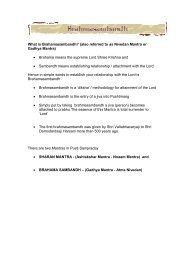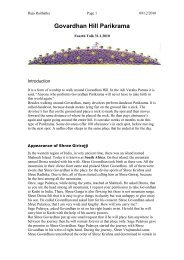Shree Bhagvat - VaishnavSangh.org.uk
Shree Bhagvat - VaishnavSangh.org.uk
Shree Bhagvat - VaishnavSangh.org.uk
Create successful ePaper yourself
Turn your PDF publications into a flip-book with our unique Google optimized e-Paper software.
<strong>Shree</strong> <strong>Bhagvat</strong>-gudharthprakashan-parayan<br />
(7 th name)<br />
• The basis of Phustimargiya is <strong>Shree</strong><br />
<strong>Bhagvat</strong>.<br />
•<strong>Shree</strong> <strong>Bhagvat</strong> is fundamental to our<br />
margh<br />
•<strong>Shree</strong> Gusaiji in reciting the 7 th name of<br />
<strong>Shree</strong> Mahaprabhuji highlights this.
<strong>Shree</strong> <strong>Bhagvat</strong>-gudharthprakashan-parayan<br />
(7 th name)<br />
• I first bow down to <strong>Shree</strong> Mahaprabhuji<br />
who has through <strong>Shree</strong> Subodhiniji and<br />
various other Granths enlightened us on<br />
<strong>Shree</strong> <strong>Bhagvat</strong><br />
•Literal meaning of the words helps in<br />
basic understanding
- gudharth-prakashan-parayan<br />
• <strong>Shree</strong> Gusaji in expressing <strong>Shree</strong><br />
Mahaprabhuji’s 7 th name refers to<br />
‘gudharth’.<br />
• this is because many Pundits have<br />
commented on <strong>Shree</strong> <strong>Bhagvat</strong> and<br />
• So they would have highlighted<br />
Pustimargiya i.e. prakashan-parayan but<br />
this <strong>Shree</strong> Gusaiji says needs to be<br />
distinguished.
<strong>Shree</strong> Gusaji says needs to be<br />
distinguished as it is<br />
- gudharth-prakashan-parayan<br />
• <strong>Shree</strong> Gusaji says <strong>Shree</strong> Mahaprabhuji<br />
has enlightened us on the deep / mystic<br />
meaning<br />
• hidden in <strong>Shree</strong> <strong>Bhagvat</strong> which other<br />
Pundit’s have not been gifted in<br />
developing and that the entitlement is that<br />
of only <strong>Shree</strong> Mahaprabhuji
<strong>Shree</strong> <strong>Bhagvat</strong> promulgates M<strong>uk</strong>ti<br />
• Moksha in Sanskrit means liberation or m<strong>uk</strong>ti<br />
• M<strong>uk</strong>ti in Sanskrit means release —both from<br />
the root "to let loose, let go“<br />
• It is the final extrication of the soul or<br />
consciousness (purusha) from samsara and<br />
the bringing to an end of all the suffering<br />
involved in being subject to the cycle of<br />
repeated death and rebirth (reincarnation).
<strong>Shree</strong> <strong>Bhagvat</strong> promulgates M<strong>uk</strong>ti<br />
• Pushtimargiya defines the benefit of <strong>Shree</strong><br />
<strong>Bhagvat</strong> as TO BE ONE WITH SHREE<br />
KRISHNA. It was explained by <strong>Shree</strong><br />
Rasiyabava that as sugar becomes one<br />
with milk and cannot be separated,<br />
• that to be tied with PURNAPURSHOTAM<br />
• This is linked with what <strong>Shree</strong> S<strong>uk</strong>devji<br />
states
<strong>Shree</strong> <strong>Bhagvat</strong> promulgates<br />
Samarpan over M<strong>uk</strong>ti<br />
• Sarnagati is the message and<br />
• Chatursolki refers to four Pursarthas<br />
• Dharma Artha, Kam, moksha<br />
• M<strong>uk</strong>ti over all the four above is<br />
• Dharma was for a cause then it is<br />
Adharma so never follow Bhakti as a<br />
Dharma
<strong>Shree</strong> <strong>Bhagvat</strong> promulgates<br />
Samarpan over M<strong>uk</strong>ti<br />
• Then what is the fruit over the four<br />
purusharthas<br />
• It is Sharnagati<br />
• <strong>Shree</strong> <strong>Bhagvat</strong> gived m<strong>uk</strong>ti to Moksha
<strong>Shree</strong> S<strong>uk</strong>devji explains in his<br />
imperishable language<br />
• The basis goes back to amrut vaani of<br />
<strong>Shree</strong> S<strong>uk</strong>devji<br />
• <strong>Shree</strong> <strong>Bhagvat</strong> is a bountiful source, like a<br />
wishing tree, that allows you to be<br />
submerged in the BAGHWAD-LILA<br />
• <strong>Shree</strong> S<strong>uk</strong>devji addresses: you souls of<br />
the earth will BE ONE in the BAGHWAD-<br />
LILA as you digest the verses of <strong>Shree</strong><br />
<strong>Bhagvat</strong>
<strong>Shree</strong> <strong>Bhagvat</strong> is a bountiful source,<br />
like a wishing tree, that allows you to<br />
be submerged in the BAGHWAD<br />
LILA<br />
• By reciting the nectar words in <strong>Shree</strong><br />
<strong>Bhagvat</strong> you gain the boon of Pustimargiya<br />
in the enhanced form (suddh<br />
Pushtimargiya)<br />
• Then to perform Bhakti you yield the fruits<br />
– to be one with PURNAPURSHOTAM
Bhakti-yoga in <strong>Shree</strong> <strong>Bhagvat</strong> is<br />
referred in various context<br />
• Bhakti-yoga is devoted attachment<br />
• Bhakti-yoga is loving devotion<br />
• Nevertheless it is not explained precisely<br />
• Laya / m<strong>uk</strong>ti / to be liberated seems to be<br />
part only of the fruit,
Bhakti-yoga in <strong>Shree</strong> <strong>Bhagvat</strong> has<br />
the boon of Pustimargiya<br />
• Indeed use of the word Alaya in <strong>Shree</strong><br />
<strong>Bhagvat</strong> elevates the boon of <strong>Shree</strong><br />
<strong>Bhagvat</strong> to Pustimargiya in the enhanced<br />
form (suddh Pushtimargiya)<br />
• And that the ability to gift this insight to us<br />
is out of entitlement that is of only <strong>Shree</strong><br />
Mahaprabhuji
To attain Pustimargiya is far is<br />
above the atainmaint of M<strong>uk</strong>ti!<br />
<strong>Shree</strong> Gokulnathji explains:<br />
• <strong>Shree</strong> <strong>Bhagvat</strong> is akin to <strong>Shree</strong><br />
Thakorji’s dwelling in heaven but this is<br />
not the relationship Pundits have<br />
expressed and that<br />
• Pushtimargiya is based on this backbone<br />
• So why is it that other Pundits have not<br />
developed this
<strong>Shree</strong> Gokulnathji clarifies why<br />
Pundits did not pick this up:<br />
• <strong>Shree</strong> Gokulnathji Pushtimargiya is<br />
based on both <strong>Shree</strong> Madh <strong>Bhagvat</strong> and<br />
<strong>Shree</strong> <strong>Bhagvat</strong> Gita as forms of Lord<br />
<strong>Shree</strong> Krishna in heaven and this had<br />
not been developed by Pundits but..<br />
• Who better can understand these forms<br />
than <strong>Shree</strong> Mahaprabhuji, the<br />
M<strong>uk</strong>harvind svaroop of the Lord<br />
himself!
<strong>Shree</strong> Gokulnathji further<br />
clarifies..<br />
• Various knowledgeable people have<br />
recognised svaroop of god as a universal<br />
sprit / formless, full of energy / glorious,<br />
• many have also experienced this also but<br />
• Pragatiya of <strong>Shree</strong> Mahaprabhuji, the<br />
M<strong>uk</strong>harvind svaroop of the Lord<br />
himself states the boon of <strong>Shree</strong> <strong>Bhagvat</strong><br />
is Pustimargiya and that is BHAKTI<br />
MARGIYA
Hence <strong>Shree</strong> Gusaji gave the<br />
name<br />
• <strong>Shree</strong> <strong>Bhagvat</strong>-gudharth-prakashanparayan
<strong>Shree</strong> <strong>Bhagvat</strong>-gudharth<br />
• Earlier we referred to Ghudartha as having<br />
a hidden/mystic meaning<br />
• In spritual sense <strong>Shree</strong> <strong>Bhagvat</strong>-gudharth<br />
means emotion/sentiments/ nectar of love<br />
for Gopis, cowherdessess<br />
• The foundation of Pushtimargiya<br />
promulgated by <strong>Shree</strong> MahaPrabhuji is<br />
Gopi bhav
Corner stone of <strong>Shree</strong> <strong>Bhagvat</strong> is<br />
prem laxana bhakti<br />
• <strong>Shree</strong> <strong>Bhagvat</strong> promotes various<br />
disciplines including bhakti, gyana, karma,<br />
sakhya, yoga, Aadi<br />
• Out of all these bhakti <strong>Shree</strong> Mahaprabhuji<br />
states premlaxana bhakti (loving devotion)<br />
is most loving<br />
• It is enjoyment of this loving devotion as<br />
what <strong>Shree</strong> S<strong>uk</strong>hdevji recommends to the<br />
earthly souls in <strong>Shree</strong> <strong>Bhagvat</strong>
<strong>Shree</strong> Vallabha and <strong>Shree</strong> <strong>Bhagvat</strong><br />
• <strong>Shree</strong> <strong>Bhagvat</strong> is valued more than own life, and<br />
it is the gold mine of Vaishnavs.<br />
• <strong>Shree</strong> Vallabha from his own experience sees<br />
the 10 Lilas in <strong>Shree</strong>Nathji’s Svaroop and hence<br />
always had Shrimadh <strong>Bhagvat</strong> with him<br />
• <strong>Shree</strong> Vallabha explains that what <strong>Shree</strong> Vyasji<br />
himself experienced in his Samadhi is what he<br />
has written and this may not appear straight<br />
forward
<strong>Shree</strong> Vallabha and <strong>Shree</strong> <strong>Bhagvat</strong><br />
• As the verses require time understading and to<br />
reflect it is likely the meaning is misunderstood<br />
or not understood.<br />
• The scriptures refers to just two situations:<br />
• the naïve question of <strong>Shree</strong> S<strong>uk</strong>hdevji about<br />
Gopis attainment of <strong>Shree</strong> Krishna’s love and<br />
similarly <strong>Shree</strong> Odhavji who was so learned and<br />
tried to consol the Gopis feelings and<br />
attachment about <strong>Shree</strong> Krishna
<strong>Shree</strong> Vallabha and <strong>Shree</strong> <strong>Bhagvat</strong><br />
• <strong>Shree</strong> Vallabha is well versed with Gopi’s<br />
pure love expressed in Shrimad <strong>Bhagvat</strong><br />
and hence titled ‘Gopika Prokta<br />
Guruvah:’ and the Guru of Pustimargiya<br />
• <strong>Shree</strong> Vallabh’s presence on earth was<br />
just to explain the gudh meaning of<br />
Prabhu’s svroop<br />
• The creation of <strong>Shree</strong> Shubodhiniji was to<br />
unveil Prabhu’s gudh svaroop
<strong>Shree</strong> Vallabha’s purpose was to<br />
unveil Prabhu’s gudh svaroop<br />
• We will learn various times <strong>Shree</strong> Vallabha<br />
has toiled over this sole mission<br />
• The 84 Betaks are defined as the holi<br />
places where <strong>Shree</strong> Vallabha did Parayan<br />
of <strong>Shree</strong>madh <strong>Bhagvat</strong><br />
• Even when <strong>Shree</strong> Krishna wanted <strong>Shree</strong><br />
Mahaprabhuji to reunite in haven twice<br />
<strong>Shree</strong> Vallabha had delayed this as the<br />
cause had not been completed
http://www.srimadbhagavatam.<strong>org</strong>/<br />
• S'rîmad Bhâgavatam (or the Bhâgavata Purâna)<br />
is the most important sacred book of stories of<br />
India. India knows many purânas or storybooks,<br />
but this collection of stories is generally<br />
accepted as being the most complete and<br />
important. The book, arranged in twelve socalled<br />
cantos, comprises 335 chapters with<br />
about 18000 verses. Truly a Bible thus. It is this<br />
collection of stories which stresses the prime<br />
importance of the maintaining aspect of God<br />
personified by the transcendental form of Lord<br />
Vishnu
<strong>Shree</strong> Vallabha’s purpose was to<br />
unveil Prabhu’s gudh svaroop<br />
• <strong>Shree</strong> Krishna’s wishes to reunite and<br />
eternal peace delayed with the sole<br />
objective of completing with total<br />
satisfaction the task of unveiling Prabhu’s<br />
gudh svaroop
<strong>Shree</strong> Vallabha’s purpose was to<br />
unveil Prabhu’s gudh svaroop<br />
• <strong>Shree</strong> Mahaprabuji’s two objectives:<br />
• To unveil the Gudh bhav of <strong>Shree</strong> <strong>Bhagvat</strong><br />
and<br />
• To liberate the souls on earth and to unite<br />
the ‘devi’ jivas <strong>Shree</strong> Krishna<br />
• I HUMBLY BOW DOWN TO SHREE<br />
VALLABH
http://www.srimadbhagavatam.<strong>org</strong>/<br />
• The writer of this book is named Krishna Dvaipâyana<br />
Vyâsadeva, also called Bâdarâyana.<br />
• Vyâsa was a grandfather of the Kuru-dynasty. He lived a<br />
very long time. His long duration of life enabled him to<br />
write the story of the Fortunate One and all the other<br />
books. He had a son called S'<strong>uk</strong>adeva who handed the<br />
message of this Bible down to another member of the<br />
family, Emperor Parîkchit, who had difficulty respecting<br />
the classical wisdom. This emperor is there as a model<br />
for us normal people who seek their stability in the<br />
wisdom. This knowledge was conveyed by S'<strong>uk</strong>a in<br />
disciplic succession (paramparâ), to those who teach<br />
by example (the âcâryas), the science of devotional<br />
service (bhakti).
From Wikipedia, the free<br />
encyclopedia<br />
• The Bhagavad Gita, also referred to as Gita, is a 700–verse Hindu<br />
scripture that is part of the ancient Sanskrit epic Mahabharata. This<br />
scripture contains a conversation between pandava prince Arjuna and his<br />
guide Krishna on a variety of philosophical issues.<br />
• Faced with a fratricidal war, a despondent Arjuna turns to his charioteer<br />
Krishna for counsel on the battlefield. Krishna, through the course of the<br />
Gita, imparts to Arjuna wisdom, the path to devotion, and the doctrine of<br />
selfless action.1 The Gita upholds the essence and the philosophical<br />
tradition of the Upanishads.2 However, unlike the rigorous monism of the<br />
Upanishads, the Bhagavad Gita also integrates dualism and theism.<br />
• Numerous commentaries have been written on the Bhagavad Gita with<br />
widely differing views on the essentials, beginning with Adi Sankara's<br />
commentary on the Gita in the eighth century CE. Commentators see the<br />
setting of the Gita in a battlefield as an allegory for the ethical and moral<br />
struggles of the human life. The Bhagavad Gita's call for selfless action<br />
inspired many leaders of the Indian independence movement including<br />
Mohandas Karamchand Gandhi, who referred to the Gita as his "spiritual<br />
dictionary".
















